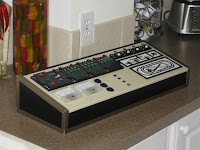zondag 17 oktober 2010
Control Panel
Since my last update, I have been working almost daily on my control panel (almost completed below). I have also finished the complete wiring plan for my control box (also seen below). The wiring plan includes the planned wiring for the control box, all lighting (including trackside signals), switch machines, power blocks, and under-table wiring. I have been working and modifying this electrical plan for quite some time now and even though it looks quite large, it�s actually quite simple, as it�s just a combination of several circuits. Some of this is already wired, such as the under-table switches, but it�s still nice to see how it will all work together.
As for the control box, it has been quite a learning experience, with lots of trial and error, blood and frustration. In the end however, the almost-finished product turned out pretty good. I planned the control panel to be a box-style board, with all the lights and switches on top of a tilted face; all wiring and electrical components stowed inside. Now I�m definitely not too experienced in wood working, but with a little research, I decided to use �� hardboard to construct the control box. Like always, I made a detailed plan of what I wanted, however cutting the board was another story. I found it almost impossible to cut the pieces perfectly straight without a table saw. I had to try several times, and after lots of dissatisfaction I finally cut some satisfactory pieces with my jig saw. I then glued it all together with Weldbond white glue.
Once dry, I measured and cut out the holes for the voltage meters. These meters will eventually monitor the cab1 and cab2 controls. I decided to go with analog gauges instead of digital ones just for a little bit more of an old-style look.
I was planning on painting my control box originally, however after constructing it, I realized that paint was not going to be enough to cover up the many cutting imperfections. I then decided to cover the box with recycled black and wicker aluminum cladding. I was not able to bend the cladding well enough to cover the box, so I cut individual pieces for all 5 sides. I also had to cut holes in the cladding to fit over the holes in the box for the voltage meters. This was quite the process, as I didn�t have anything to cut a perfect circle out the size I needed. To do this, I used a small drill bit to drill several dozen holes around the traced circle. I then re-drilled these holes with a larger bit until the holes all connected and the center circle fell out. With a bit of modification and filing, it fit perfectly over the control box holes.
For the corners and trim, I used �� steel �L� molding, which was also a huge pain to cut perfectly. The finished product turned out better than expected, however there are some noticeable imperfections. I used PL Ultimate construction adhesive to hold the molding on, which worked great. At this time I also positioned then attached all of my Atlas switches on the face of the control panel to get a good idea of the direction I was going.
The next item for construction was the display for the turnout positions as well as the 13 power blocks. I had originally planned to show all of these on one diagram, but because I had the room and didn�t want everything looking cluttered, I separated the 2 diagrams. I cut frames for each diagram out of 1/16� craft wood board and stained it dark ebony. For the diagrams, I decided to use digital vector images I created in Photoshop instead of using the traditional tape-method. I then printed these high resolution images on photo paper at Wal-Mart. Once glued to the frames, I glued the entire units directly onto the control board. The numbers on the diagrams correspond to the switch numbers and the power blocks.
Next I drilled holes through the switch position diagram and installed my LEDs which will indicate the switch�s position; red for the turnout and green for the main line. Switches 1-3 are all for the main front line and switch 4 is for the turnout to the turntable.
The LEDs at the top of each switch control are for stick-protection. I�ve heard that Atlas switch controls sometimes stick and will burn out switch machines, so I added this little feature that will indicate a stuck switch. The LED will light only for the moment that the switch is pressed. If the switch sticks, the LED will stay on, indicating power overload (see wiring diagram above). I then drilled more holes for the switches and indicators for the accessories, such as layout and power LEDs.
Once everything was attached, I started to label all of the Atlas switches. The numbers that were included with the switches didn�t fit correctly, nor did they look good, so I constructed my own, once again in Photoshop. The original ones I designed were black letters and numbers on white. The bright white stood out too much, so I inverted them, with white font on black background.
Once printed, I cut each letter out, put it on double sided tape, and stuck it to each switch. The final look was much more conservative.
I will still need to label the rocker switches and some of the other LEDs on the control panel, but the almost complete product turned out pretty well. The next step will be all of the wiring. The control box will eventually be mounted to a piece of plywood with the cab controller right beside it. The final plan is to have the entire unit fold away under my layout, but that situation of for another day.
?
Abonneren op:
Reacties posten (Atom)


















Geen opmerkingen:
Een reactie posten